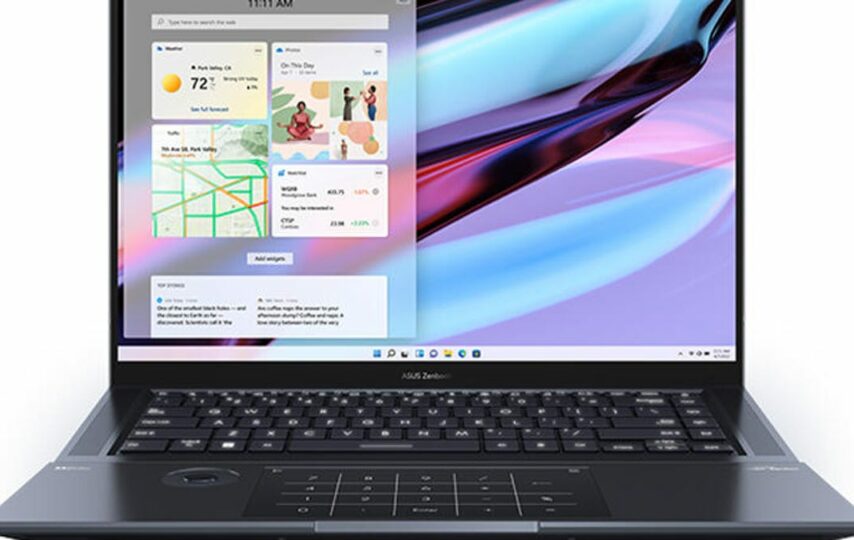[ad_1]
Pros
- High-end specifications
- Excellent 16-inch OLED screen
- Great speakers
- Asus Dial for use with specific apps
Cons
- Expensive
- Bulky and heavy
- Asus Dial functionality is limited
- All-day battery life may be a stretch
Asus’s laptops aimed at creators, like the Pro Art Studiobook 16 OLED I reviewed back in December 2021, include specialist features such as the circular Asus Dial, along with high-end components. The new Zenbook Pro 16X OLED (UX7602), which Asus describes as “the most powerful Zenbook ever”, also features the Asus Dial, along with a 4K OLED screen, a 12th-generation Intel Core i9 processor and 2TB of SSD storage. All this technology comes at a high price, though: the Asus Zenbook Pro 16X OLED (UX7602) costs £2,999.99 (~$3,682 at the time of writing).
The 16-inch Zenbook Pro 16X OLED is a sturdy and well-made laptop, but it’s also big and heavy. It weighs 2.4kg, and that’s without the enormous 200W power brick. The laptop measures 355mm by 251mm on the desktop and is 17.8mm thick at the back, tapering slightly to 16.9mm at the front. If you need to carry it, you’ll need a large bag and plenty of muscle-power.
Asus Zenbook Pro 16X OLED (UX7602): 12th-generation Core i9 processor, discrete Nvidia graphics, 16-inch OLED touch screen, 32GB of RAM, 2TB of SSD storage. Images: Asus
The aluminium alloy unibody chassis, which complies with MIL-STD 810H, affords plenty of protection to the high-end components within, while the cooling system is augmented by the AAS Ultra tilt mechanism that raises the keyboard to comfortable angle (more on that below).
The screen is superb, as befits a top-end ‘creator’ laptop. The 16-inch OLED touchscreen offers 4K resolution (3840 x 2400 pixels, 283ppi) in a 16:10 aspect ratio that provides a tall viewing area. The bezels are small, although noticeable, with the bottom one in particular being rather deep. Asus claims a screen to body ratio of 90%, although our calculation puts it at 83.3%.
Peak brightness is 550nits, and the 60Hz refresh rate, while lagging behind the 120Hz-plus of many flagship-class phones, delivers smooth and watchable video. All the usual certifications for colour and display quality are in place: Dolby Vision, Pantone Validated, VESA DisplayHDR True Black 500 certified. The screen supports 100% of the DCI-P3 colour gamut and is TÜV Rheinland certified for low blue-light emissions.
The screen supports the Asus Pen 2.0, although this stylus was not included with my review unit.
Some creative users will require high-quality audio in addition to top-end visuals, and the Zenbook Pro 16X OLED’s six speakers — two tweeters and four woofers — do an excellent job on this front. There are speaker grilles on either side of the keyboard, plus a second pair of much smaller grilles on the front underside of the chassis. Sound quality is good, with no discernible distortion even at the (quite loud) top volume.
It’s good to see a 1080p FHD camera on-board. Video quality is very good, and the camera is also equipped with IR to support Windows Hello face authentication. The webcam can be disabled for privacy purposes simply by hitting the F10 key.
When the lid is opened the AAS Ultra mechanism elevates keyboard to a 7-degree angle, lifting its back edge 14.5mm from the horizontal. Asus says this is the perfect angle for ergonomic typing, although I didn’t find it any more or less comfortable than on a traditional keyboard. Asus also claims that the tilt angles the speakers towards the user for better stereo reproduction. However, the key benefit of the tilt mechanism is its role in the laptop’s cooling system, allowing 38% more airflow and improving heat dissipation.
This enhanced airflow is vital given the Zenbook Pro 16X OLED’s powerful 12th-generation Intel Core i9-12900H processor and discrete Nvidia graphics, and it’s only part of the cooling story. Asus’s IceCool Pro system features two IceBlades fans, each of which have 97 3D-curved blades, that expel hot air through the space created by the keyboard lift.
Many 16-inch laptops fit a separate number pad into the keyboard, but Asus builds this feature into the large haptic touchpad. The Asus Dial to the left of the touchpad gives access to system-wide and application-specific controls. Image: Sandra Vogel / ZDNet
The keyboard has a backlight which can be cycled through three brightness levels via a Fn key. This is standard functionality, but more unusual are the user-configurable multicolour effects. Various hues can traverse the keyboard and illuminate light bars to its left and right. You can configure colourways for power up, power down, when performance modes are switched, when email comes in, when a USB device is attached, and more. And when the battery gets low, lights glow red. The Asus marque on the lid can also be configured to illuminate in your choice of colours.
The keyboard’s keys are a little larger than usual, taking full advantage of the available width, and they are very slightly concave — so slightly, in fact, that it’s barely noticeable. I found typing comfortable, with the 1.4mm key travel and vigorous bounce-back creating a positive key action.
The main reason the keys are larger than we might usually expect is that Asus has not squeezed a separate number pad into the keyboard. Instead, this can be found on the touchpad, where it’s called up by tapping an icon in the top right corner. The pad itself is enormous at 150mm wide and 90mm tall, and it delivers haptic feedback that confirms actions have been made. It’s responsive and comfortable to use.
Sitting to the left of the touchpad is the Asus Dial, a circular touch-sensitive area with a central button. This allows for a range of system-wide controls such as screen brightness, volume and scrolling. Users of Adobe Photoshop, Premiere Pro, Photoshop Lightroom Classic, After Effects and Illustrator can also use it to access menu options. The idea is that it provides easy, seamless access to controls without interrupting your creative flow.
It’s a shame the Asus Dial’s application-based functionality is currently limited to a small set of apps, as users of other creativity tools will miss out on its productivity benefits.
Asus has built the Zenbook Pro 16X OLED to be a powerhouse for creative users, and with that in mind there’s just one high-end processor option — Intel’s Core i9-12900H. This is supported by a discrete Nvidia GeForce RTX 3060 GPU. There is 32GB of non-expandable RAM and a 2TB PCIe 4.0 SSD. That’s far more storage than would normally be provided as standard, but likely necessary for all the multimedia material that users will need to store.
Left side (top): DC-in, USB-A (3.2 Gen 2), 2x Thunderbolt 4. Right side (above): SD card reader, 3.5mm audio in/out, HDMI 2.1. Note the raised keyboard, which reaches a 7-degree angle when the clamshell is fully open. Image: Sandra Vogel / ZDNet
Ports and connectors are plentiful by today’s standards too. A pair of Thunderbolt 4 ports are always free, thanks to the presence of a dedicated power input. There’s a single USB-A port and a full-size HDMI port as well as a 3.5mm audio in/out jack. The SD card slot is specified as SD Express 7.0, making it fast enough for exchanging large data files — as long as your memory card also supports this standard.
With power-hungry components and a large screen to keep going, battery life could be a concern. Has Asus done enough to ensure the Zenbook Pro 16X OLED can see users through extended periods without being tethered to the mains?
I ran my standard mainstream workload mix of writing into web apps, steaming and browsing. This is hardly the onslaught this Core i9 system might expect from creative users, so we can regard it as a light workload for this system.
Over three hours the 96Wh battery lost 37% from a full charge, suggesting total battery life of just over 8 hours. It’s worth noting that my review laptop was not a final production unit, so this result isn’t too far off Asus’s claim of ‘up to’ 10 hours.
Still, with more demanding workloads, the Zenbook Pro 16X OLED UX7602 might struggle to deliver a full day’s work between charges. I did not test charging speed.
Conclusions
The Asus Zenbook Pro 16X OLED (UX7602) is large and powerful laptop. It’s robustly designed, with an unusual angled keyboard, a large trackpad with an integrated number pad and the Asus Dial, as well as an excellent 16-inch OLED touch screen.
The fancy keyboard backlighting might be a bit over the top for some, but the Core i9 processor, 2TB of storage, excellent speakers and even the FHD IR webcam mark this laptop out as special. Just be aware of potential limitations of battery life and the Asus Dial’s limited application support.
Asus Zenbook Pro 16X OLED (UX7602) specifications
| OS | Windows 11 (Home or Pro) |
| Processor | Intel Core i9-12900H |
| RAM | 32GB (LPDDR5) |
| Storage | 2TB (M.2 NVMe PCIe 4.0 Performance SSD) |
| Graphics | Intel Iris Xe Graphics (integrated), Nvidia GeForce RTX 3060 Laptop GPU (discrete) |
| Display | 16-inch OLED touchscreen, 4K (3840 x 2400, 16:10, 283ppi) |
| Refresh rate | 60Hz |
| Response time | 0.2ms |
| Brightness | 550 nits (peak) |
| Colour gamut | DCI-P3 (100%) |
| Colour depth | 10-bits/pixel (1.07 billion colours) |
| Certifications | Dolby Vision, Display HDR True Black 500, Pantone Validated |
| Ergonomics | TÜV Rheinland-certified, SGS Eye Care Display |
| Ports | USB-A (3.2 Gen 2), 2x Thunderbolt 4 (display & power delivery), HDMI 2.1, 3.5mm audio in/out jack, DC-in, SD Express 7.0 card reader |
| Keyboard & touchpad | customisable per-key white RGB backlit keyboard, 1.4mm key travel; 150mm x 90mm haptic touchpad with Asus NumberPad 2.0 |
| Other input devices | Asus Dial (integrated), Asus Pen 2.0 (optional) |
| Camera | FHD with IR for Windows Hello authentication, privacy shutter |
| Audio | 6 speakers (2x tweeters, 4x woofers), 4-mic array with AI noise cancellation |
| Wi-Fi | Wi-Fi 6E |
| Bluetooth | 5.2 |
| Battery | 96Wh |
| Battery life | up to 10 hours |
| Power supply | 200W AC adapter |
| Dimensions | 355mm x 251mm x 16.9-17.8mm (13.98in. x 9.88in. x 0.67-0.70in.) |
| Weight | 2.4kbg (5.29lbs) |
| Ruggedness | MIL-STD 810H |
| Applications | MyASUS, ProArt Creator Hub |
| Security | BIOS booting user password protection, Trusted Platform Module (TPM) 2.0, fingerprint sensor (integrated with power key), IR webcam with Windows Hello support, McAfee LiveSafe 30-day trial |
| Price | £2,999.99 |
Alternatives to consider
Laptops with 16-inch screens are relatively new to the market, but there’s already a good choice of products in this form factor, which offers a decent amount of screen real estate while avoiding the extremes of bulk and weight found in many 17-inch devices. Here’s a couple of leading contenders. For more on laptops aimed at creators, check out ZDNet’s roundup.
RECENT AND RELATED CONTENT
OLED laptops for creators: New Zenbooks and Vivobooks from Asus
CES 2022: Asus launches 17-inch folding OLED laptop and space-themed Zenbook
Asus ProArt Studiobook 16 OLED (H5600) review: A top-quality 16-inch mobile workstation for creative pros
Asus ZenBook Pro Duo 15 OLED (UX582L) review: A premium dual-screen laptop for creative pros
The best laptops for graphic design: Top creator notebooks
Read more reviews
[ad_2]








